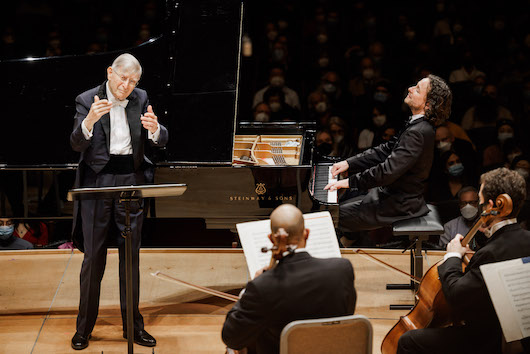Blomstedt leads BSO in a streamlined yet spiritual Bruckner Fourth

Herbert Blomstedt conducted the Boston Symphony Orchestra in music of Mozart and Bruckner Thursday night at Symphony Hall. Photo: Aram Boghosian
The final measures of Bruckner’s Symphony No. 4 are celebrated and unmistakeable: a horn call from the opening movement soars over a frenzy of triplets to bring the work full circle.
Yet a recent edition by musicologist Benjamin Korstvedt omits that culminating gesture, tightens the musical structure, and allows the music to unfold with greater ease.
Conductor Herbert Blomstedt has an affinity for this 2018 version—Korstvedt even dedicated his edition to the conductor—and Thursday night at Symphony Hall, he led the Boston Symphony Orchestra in this new-look Fourth Symphony by revealing that less can be more.
Bruckner revised the symphony after the 1874 original was deemed unplayable by members of the Vienna Philharmonic. Each successive rewrite survives through published scores and recordings, though the Nowak edition of the 1880 version has unofficially stood as Bruckner’s final word for much of the twentieth century.
But Korstvedt challenges that assessment by suggesting that Bruckner’s intermittent revisions, often made with the help of others, did not necessarily compromise his artistic integrity. Drawing upon the composer’s manuscripts, Korstvedt trims the symphony of what some would regard as its excess while keeping intact its familiar grandeur and lyricism.
In Blomstedt’s hands, this streamlined version also retains Bruckner’s stirring intensity. The 94-year-old conductor’s feel for this music has only deepened over the decades. Tempos were swift without being rigid, textures resonated in ideal balance, and the energy built steadily over each movement.
But Bruckner’s strengths rest in his ability to prolong a single moment, and Blomstedt lingered in all the right places. The opening horn call seemed to emerge out of the mist. String lines flowered in the first movement, and the brass delivered palpable weight in the climactic moments.
The BSO played with a depth and dimension not experienced in recent performances of this score, with Blomstedt reveling in every detail. Woodwind solos provided supple complement to the lower strings in the mysterious development section. Unison statements also brought fatalistic power to the finale.
Shaped with subtle dynamics, the melodies of the Andante took the shape of an Austrian air. The Scherzo coursed urgently, with the Trio offering bucolic departure. The finale unfolded with an improvisatory freedom. Yet Blomstedt always kept an eye to the larger picture, the sudden fortes and pianissimos foreshadowing the concluding peroration. As with his other symphonies, the Fourth Symphony reflects a deep spirituality and Blomstedt and the orchestra provided that quality in this memorable performance.
The evening began with Mozart’s Piano Concerto No. 17, featuring Martin Helmchen as soloist.

Martin Helmchen performed Mozart’s Piano Concerto No. 17 with Herbert Blomstedt and the BSO Thursday night. Photo: Aram Boghosian
On the surface, there was much to like about Helmchen’s clarity and precision. Yet his overly percussive touch failed to blend with Blomstedt’s rich accompaniment in the outer movements. The German pianist frequently missed the chance to find a chamber-like delicacy, the woodwind solos answered throughout by a cascade of unrelenting pings. What emerged was an awkward, crystalline picture framed by a plush cushion.
Helmchen played with greater sensitivity in the central movement, softening his touch when the music turned toward darkness. But he consistently appeared a soloist out of his element. He reserved his most arresting playing for the cadenzas, scenes of poignant, albeit solitary, musicality.
Helmchen rewarded the applause with an encore of the Adagio from Mozart’s Piano Sonata No. 12, K.332. Given this tender and lyrical performance, one felt that he best worked alone, at last on this occasion.
The program will be repeated 1:30 p.m. Friday and 8 p.m. Saturday at Symphony Hall. bso.org
Posted in Performances